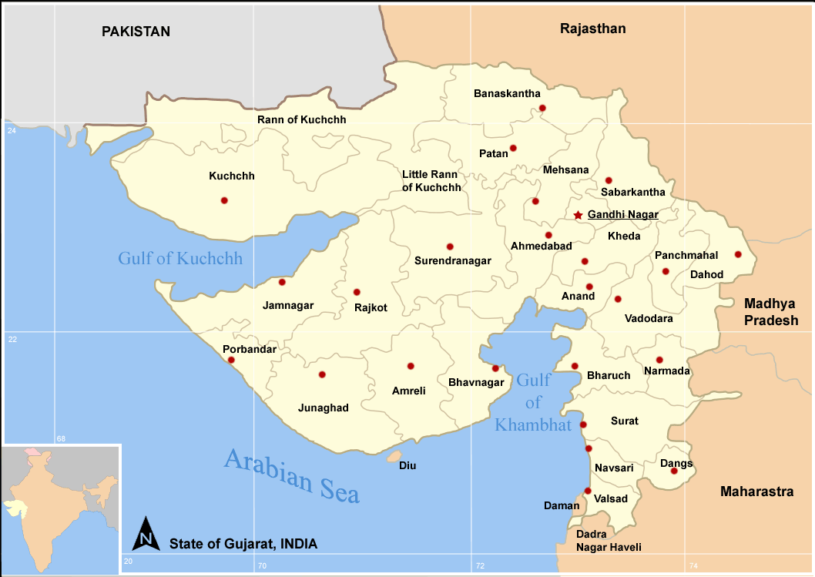By Alison Saldanha
Among larger Indian states, Gujarat has the least number of vaccinated children: 50.4 per cent (2015-16 data). The immunisation rate of the fourth-richest state (2013-14) is now worse than that of some of the most backward states — Bihar, Madhya Pradesh, Rajasthan and Uttar Pradesh, called Bimaru (or sick) states.
While Gujarat’s current immunisation rate is up 11.5 per cent from the previous decade, it is now 11.6 percentage points below the national average of 62 per cent, according to an IndiaSpend analysis of National Family Health Survey (NFHS) data from 1991 to 2015-16.
In 2005-06, the state’s vaccination coverage, at 45.2 per cent, had been above India’s average of 43.5 per cent. Further, the current numbers are only slightly higher than the figures the state reported 23 years ago, in 1992-93.
 Till recently, the Bimaru states, along with Arunachal Pradesh, Nagaland, Assam and Meghalaya, held the worst child vaccination records in the country.
Till recently, the Bimaru states, along with Arunachal Pradesh, Nagaland, Assam and Meghalaya, held the worst child vaccination records in the country.
Immunisation is known to be the most cost-effective method to prevent disease and death. Every year, India loses 500,000 children under the age of two due to diseases preventable by vaccination.
Across India, the percentage of children who have received full immunisation that includes polio, BCG, DPT, and measles vaccines, has dramatically risen over 40 per cent in the last 10 years — from 43.5 per cent in NFHS round three in 2005-06 to 62 per cent in round four.
This is mainly due to the significant growth in vaccination coverage in Uttar Pradesh, Rajasthan, Bihar and Jharkhand. In the 2005-06 survey, these states recorded dismal percentages of children vaccinated: 23, 26.5, 32.8 and 34.8 per cent, respectively. They have witnessed a median improvement of 97.45 per cent — with Uttar Pradesh registering a 122 per cent jump — in immunisation coverage to now reach 51.1, 54.8, 61.7 and 61.9 per cent of the population, respectively.
Punjab, Goa, and West Bengal recorded the highest numbers in immunisation of children between the ages of between 12 and 23 months.
While Punjab and Goa registered a negative growth in immunisations of 16.6 per cent and 4.8 per cent in 2005-06, as per the latest NFHS data their rates did grow at 48.3 per cent and 12.5 per cent, respectively. West Bengal recorded a 31.3 per cent growth in immunisation, 15.6 per cent points lower than its growth rate in 2005-06.
Meanwhile, Gujarat aside, growth of immunisation coverage in the large prosperous states of Maharashtra and Tamil Nadu has also particularly slumped.
Maharashtra, India’s richest state, recorded a decline of 4.3 per cent in the number of children vaccinated in 2015-16 over 2005-06. It now fares worse than Bihar which has witnessed an 88.1 per cent growth in the same period.
While in NFHS round three (2005-06), Tamil Nadu was the state with the highest rate of immunisation at 80.9 per cent of children vaccinated, a decade later the state has recorded a 13.8 per cent decline. As of 2015-16, only 69.1 per cent of children were vaccinated in the southern state with the country’s second-largest economy.
Uttarakhand too saw a 3.8 per cent drop in percentage of children immunised from 60 per cent a decade ago. The young state, has been otherwise recording significant growth in its state gross domestic product, per capita income, poverty reduction, and literacy and performing better than its parent state.
While much of the north-east showed low immunisation of children in the latest survey — with Nagaland recording the lowest percentage — five of seven states in this region still showed significant improvement since 2005-06. From 33 per cent a decade ago, Meghalaya recorded a notable growth of 87 per cent in vaccination coverage. The percentage of children receiving full immunisation grew 70 per cent in Nagaland, and 50 per cent in Assam.
In December 2014, Mission Indradhanush was launched with the goal of increasing immunisation by five per cent every year. This would ensure that 90 per cent of children are immunised by 2020.
During the first phase of the mission, the government identified 201 “high-focus” districts accounting for nearly 50 per cent of all unvaccinated or partially vaccinated children in the country.
Of these, 82 districts were in the Bimaru states — 14 in Bihar, 15 in Madhya Pradesh, nine in Rajasthan and 44 in Uttar Pradesh –where 25 per cent of the unvaccinated or partially vaccinated children reside.
The increased focus on these states may thus be credited with the significant progress in immunisation efforts here. The shift in focus from the more prosperous states may have also contributed to their slow growth in vaccination coverage.
There are several reasons for partial or no immunisation, but the most common ones are: not convinced about the need and lack of awareness.
This was also reflected in the findings from Gujarat, where not feeling the need for vaccines (22.3 per cent) and not knowing about the vaccines (15.5 per cent) were the primary two reasons for low immunisation.
In the north-east where vaccination coverage is particularly low, a median 44.9 per cent did not feel the need to vaccinate their children.
Further, full immunisation is more complicated as it requires receiving vaccination doses at different times. Possible reasons for Gujarat’s poor performance could be that its health institutions, clinics and nurses who provide regular check-ups and care are less efficient and capable than in many other states, according to a 2015 report in The Economist. (IANS)












